[English] 日本語
 Yorodumi
Yorodumi- PDB-8t6r: Acinetobacter baumannii 118362 family 2A cargo-loaded encapsulin shell -
+ Open data
Open data
- Basic information
Basic information
| Entry | Database: PDB / ID: 8t6r | ||||||
|---|---|---|---|---|---|---|---|
| Title | Acinetobacter baumannii 118362 family 2A cargo-loaded encapsulin shell | ||||||
 Components Components | Major membrane protein I | ||||||
 Keywords Keywords | VIRUS LIKE PARTICLE / encapsulin / protein nanocompartment | ||||||
| Function / homology | :  Function and homology information Function and homology information | ||||||
| Biological species |  Acinetobacter baumannii 118362 (bacteria) Acinetobacter baumannii 118362 (bacteria) | ||||||
| Method | ELECTRON MICROSCOPY / single particle reconstruction / cryo EM / Resolution: 1.78 Å | ||||||
 Authors Authors | Andreas, M.P. / Benisch, R. / Giessen, T.W. | ||||||
| Funding support |  United States, 1items United States, 1items
| ||||||
 Citation Citation |  Journal: Sci Adv / Year: 2024 Journal: Sci Adv / Year: 2024Title: A widespread bacterial protein compartment sequesters and stores elemental sulfur. Authors: Robert Benisch / Michael P Andreas / Tobias W Giessen /  Abstract: Subcellular compartments often serve to store nutrients or sequester labile or toxic compounds. As bacteria mostly do not possess membrane-bound organelles, they often have to rely on protein-based ...Subcellular compartments often serve to store nutrients or sequester labile or toxic compounds. As bacteria mostly do not possess membrane-bound organelles, they often have to rely on protein-based compartments. Encapsulins are one of the most prevalent protein-based compartmentalization strategies found in prokaryotes. Here, we show that desulfurase encapsulins can sequester and store large amounts of crystalline elemental sulfur. We determine the 1.78-angstrom cryo-EM structure of a 24-nanometer desulfurase-loaded encapsulin. Elemental sulfur crystals can be formed inside the encapsulin shell in a desulfurase-dependent manner with l-cysteine as the sulfur donor. Sulfur accumulation can be influenced by the concentration and type of sulfur source in growth medium. The selectively permeable protein shell allows the storage of redox-labile elemental sulfur by excluding cellular reducing agents, while encapsulation substantially improves desulfurase activity and stability. These findings represent an example of a protein compartment able to accumulate and store elemental sulfur. | ||||||
| History |
|
- Structure visualization
Structure visualization
| Structure viewer | Molecule:  Molmil Molmil Jmol/JSmol Jmol/JSmol |
|---|
- Downloads & links
Downloads & links
- Download
Download
| PDBx/mmCIF format |  8t6r.cif.gz 8t6r.cif.gz | 66.5 KB | Display |  PDBx/mmCIF format PDBx/mmCIF format |
|---|---|---|---|---|
| PDB format |  pdb8t6r.ent.gz pdb8t6r.ent.gz | 47.6 KB | Display |  PDB format PDB format |
| PDBx/mmJSON format |  8t6r.json.gz 8t6r.json.gz | Tree view |  PDBx/mmJSON format PDBx/mmJSON format | |
| Others |  Other downloads Other downloads |
-Validation report
| Summary document |  8t6r_validation.pdf.gz 8t6r_validation.pdf.gz | 1.4 MB | Display |  wwPDB validaton report wwPDB validaton report |
|---|---|---|---|---|
| Full document |  8t6r_full_validation.pdf.gz 8t6r_full_validation.pdf.gz | 1.4 MB | Display | |
| Data in XML |  8t6r_validation.xml.gz 8t6r_validation.xml.gz | 30.3 KB | Display | |
| Data in CIF |  8t6r_validation.cif.gz 8t6r_validation.cif.gz | 41.4 KB | Display | |
| Arichive directory |  https://data.pdbj.org/pub/pdb/validation_reports/t6/8t6r https://data.pdbj.org/pub/pdb/validation_reports/t6/8t6r ftp://data.pdbj.org/pub/pdb/validation_reports/t6/8t6r ftp://data.pdbj.org/pub/pdb/validation_reports/t6/8t6r | HTTPS FTP |
-Related structure data
| Related structure data |  41078MC M: map data used to model this data C: citing same article ( |
|---|---|
| Similar structure data | Similarity search - Function & homology  F&H Search F&H Search |
- Links
Links
- Assembly
Assembly
| Deposited unit | 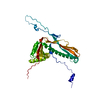
|
|---|---|
| 1 | x 60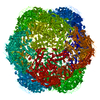
|
| 2 |
|
| 3 | x 5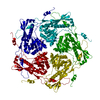
|
| 4 | x 6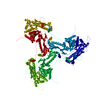
|
| 5 | 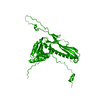
|
| Symmetry | Point symmetry: (Schoenflies symbol: I (icosahedral)) |
- Components
Components
| #1: Protein | Mass: 34609.195 Da / Num. of mol.: 1 Source method: isolated from a genetically manipulated source Source: (gene. exp.)  Acinetobacter baumannii 118362 (bacteria) Acinetobacter baumannii 118362 (bacteria)Gene: mmpI, J517_0527 / Production host:  |
|---|
-Experimental details
-Experiment
| Experiment | Method: ELECTRON MICROSCOPY |
|---|---|
| EM experiment | Aggregation state: PARTICLE / 3D reconstruction method: single particle reconstruction |
- Sample preparation
Sample preparation
| Component | Name: Acinetobacter baumannii 118362 family 2A cargo-loaded encapsulin shell Type: COMPLEX Details: Acinetinobacter baumannii 118362 family 2A encapsulin shell with internal cysteine desulfurase cargo protein Entity ID: all / Source: RECOMBINANT | |||||||||||||||
|---|---|---|---|---|---|---|---|---|---|---|---|---|---|---|---|---|
| Molecular weight | Value: 1.88 MDa | |||||||||||||||
| Source (natural) | Organism:  Acinetobacter baumannii 118362 (bacteria) Acinetobacter baumannii 118362 (bacteria) | |||||||||||||||
| Source (recombinant) | Organism:  | |||||||||||||||
| Buffer solution | pH: 7.5 / Details: 150 mM NaCl, 20 mM Tris pH 7.5 | |||||||||||||||
| Buffer component |
| |||||||||||||||
| Specimen | Conc.: 3 mg/ml / Embedding applied: NO / Shadowing applied: NO / Staining applied: NO / Vitrification applied: YES | |||||||||||||||
| Specimen support | Details: 60 seconds at 5 mA / Grid material: COPPER / Grid mesh size: 200 divisions/in. / Grid type: Quantifoil R1.2/1.3 | |||||||||||||||
| Vitrification | Instrument: FEI VITROBOT MARK IV / Cryogen name: ETHANE / Humidity: 100 % / Chamber temperature: 295 K Details: Blot force: 20 Blot time: 4 seconds Drain time: 0 Wait time: 0 |
- Electron microscopy imaging
Electron microscopy imaging
| Experimental equipment |  Model: Titan Krios / Image courtesy: FEI Company |
|---|---|
| Microscopy | Model: TFS KRIOS |
| Electron gun | Electron source:  FIELD EMISSION GUN / Accelerating voltage: 300 kV / Illumination mode: FLOOD BEAM FIELD EMISSION GUN / Accelerating voltage: 300 kV / Illumination mode: FLOOD BEAM |
| Electron lens | Mode: BRIGHT FIELD / Nominal magnification: 105000 X / Nominal defocus max: 1000 nm / Nominal defocus min: 500 nm / Cs: 2.7 mm / C2 aperture diameter: 100 µm |
| Specimen holder | Cryogen: NITROGEN |
| Image recording | Average exposure time: 3 sec. / Electron dose: 54 e/Å2 / Film or detector model: GATAN K3 BIOQUANTUM (6k x 4k) / Num. of grids imaged: 1 / Num. of real images: 5936 |
| Image scans | Width: 5760 / Height: 4092 |
- Processing
Processing
| EM software |
| ||||||||||||||||||||||||||||||||||||||||||||||||||
|---|---|---|---|---|---|---|---|---|---|---|---|---|---|---|---|---|---|---|---|---|---|---|---|---|---|---|---|---|---|---|---|---|---|---|---|---|---|---|---|---|---|---|---|---|---|---|---|---|---|---|---|
| CTF correction | Type: PHASE FLIPPING AND AMPLITUDE CORRECTION | ||||||||||||||||||||||||||||||||||||||||||||||||||
| Particle selection | Num. of particles selected: 695842 | ||||||||||||||||||||||||||||||||||||||||||||||||||
| Symmetry | Point symmetry: I (icosahedral) | ||||||||||||||||||||||||||||||||||||||||||||||||||
| 3D reconstruction | Resolution: 1.78 Å / Resolution method: FSC 0.143 CUT-OFF / Num. of particles: 596718 / Symmetry type: POINT | ||||||||||||||||||||||||||||||||||||||||||||||||||
| Atomic model building | B value: 28.96 / Protocol: FLEXIBLE FIT / Space: REAL / Target criteria: cross-correlation coefficient | ||||||||||||||||||||||||||||||||||||||||||||||||||
| Atomic model building | PDB-ID: 6X8M Accession code: 6X8M / Source name: PDB / Type: experimental model |
 Movie
Movie Controller
Controller


 PDBj
PDBj
